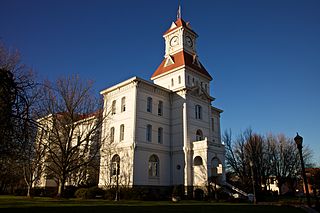
Reser Stadium is an outdoor athletic stadium in the northwest United States, on the campus of Oregon State University in Corvallis, Oregon. It is the home of the Oregon State Beavers of the Pac-12 Conference, and opened 66 years ago in 1953 as Parker Stadium. It was renamed in 1999, and its current seating capacity is 43,363. The FieldTurf playing field runs northwest to southeast, at an approximate elevation of 240 feet (73 m) above sea level, with the press box above the grandstand on the southwest sideline.

The LaSells Stewart Center is the performing arts and conference center on the Oregon State University campus in Corvallis, Oregon, USA. The Stewart Family donated the money used to construct the center, and it is dedicated to the memory of LaSells Stewart.

Oregon State University's College of Engineering is a college within Oregon State University.
The Linus Pauling Institute is a research institute located at the Oregon State University with a focus on health maintenance. The mission statement of the institute is to determine the functional roles of micronutrients and phytochemicals in promoting optimal health and to treat or prevent human disease, and to determine the role of oxidative stress and inflammation in health and disease. There are several major areas of research occurring at the institute, focused on many vitamins, minerals and other compounds found in the diet.
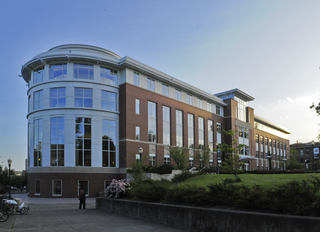
The Valley Library is the primary library of Oregon State University and is located at the school's main campus in Corvallis in the U.S. state of Oregon. Established in 1887, the library was placed in its own building for the first time in 1918, what is now Kidder Hall. The current building opened in 1963 as the William Jasper Kerr Library and was expanded and renamed in 1999 as The Valley Library. The library is named for philanthropist F. Wayne Valley, who played football for Oregon State.

The Oregon State University Radiation Center (OSURC) is a research facility that houses a nuclear reactor at Oregon State University (OSU) in Corvallis, Oregon, United States. The Oregon State TRIGA Reactor (OSTR) serves the research needs of the OSU nuclear engineering department along with other departments.

Oregon State University - Cascades (OSU-Cascades) is a branch campus of Oregon State University (OSU) located in Bend, Oregon. It is the only university in Central Oregon that offers both baccalaureate and graduate programs. OSU-Cascades also offers professional pathways and certificate programs. The 10-acre campus is the first public university to open in Oregon in more than 50 years. The campus plans to expand academically with new degree programs over a 10-year period.

The history of Oregon State University in Corvallis, Oregon, United States, began in the era of the Oregon Territory. At first a private school, the college later became a state supported agricultural institution. Nineteen presidents have led the school over the years while the school has been transformed from a single building to a campus of 577 acres (2.34 km2) and approximately 30,000 students in 2015.

Bell Field, originally known as College Field (1893–1909), was an outdoor athletic stadium in the northwest United States, on the campus of Oregon State College in Corvallis, Oregon. It was the home venue of Oregon State Beavers football prior to the opening of Parker Stadium in November 1953.
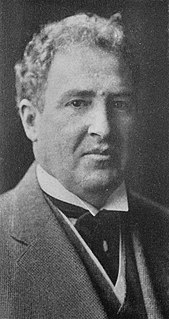
John Virginius Bennes was an American architect who designed numerous buildings throughout the state of Oregon, particularly in Baker City and Portland. In Baker City he did an extensive redesign of the Geiser Grand Hotel, designed several homes, and a now-demolished Elks building. He moved to Portland in 1907 and continued practicing there until 1942.

Charles Henry Burggraf (1866–1942) was an American architect primarily working in Salem, Oregon and Albany, Oregon, who also worked in Hastings, Nebraska and in Grand Junction, Colorado. A number of his works are listed on the U.S. National Register of Historic Places (NRHP).
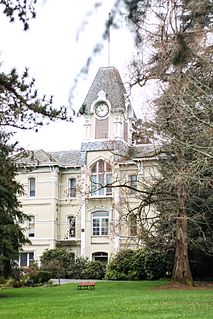
Benton Hall is the first building constructed on the Oregon State University campus in Corvallis, Oregon. It was originally known as the Administration Building of the institution's former name, State Agricultural College. The building's cornerstone was laid by the Ancient Free and Accepted Masons of Oregon on August 17, 1887. It opened in September 1889.
Dryden Hall is a building located at 450 Southwest 30th Street on the Oregon State University campus in Corvallis, Oregon, United States.
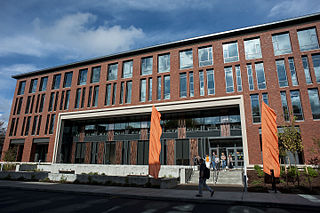
Austin Hall is a building located at 2751 Southwest Jefferson Avenue on the Oregon State University campus in Corvallis, Oregon, United States. The building, home to the Oregon State University College of Business, is named after and primarily funded by Ken and Joan Austin. Mr. Austin, alumni of the College Business, founded A-dec, a dental office furniture and equipment manufacturer based in Newberg, Oregon, United States, with his wife Joan in 1964. The building was designed by THA Architecture, and built by Andersen Construction.

Merryfield Hall is a building located at 1600 Southwest Monroe Avenue on the Oregon State University campus in Corvallis, Oregon, United States.
Peavy Hall is a building located at 3100 Southwest Jefferson Way on the Oregon State University campus in Corvallis, Oregon, United States.
Owen Hall is a building located in 1501 Southwest Campus Way on the Oregon State University campus in Corvallis, Oregon, United States.

Dixon Recreation Center is located on the Oregon State University campus in Corvallis, Oregon, United States.

The Oregon State University College of Business is one of 12 colleges that comprise Oregon State University (OSU) in Corvallis, Oregon. The land-grant institution opened in 1868 as Oregon Agricultural College.


